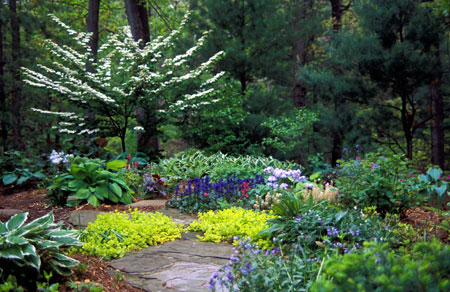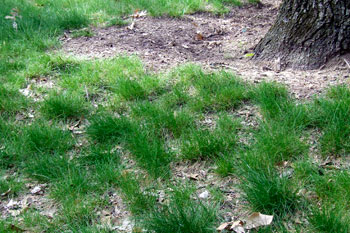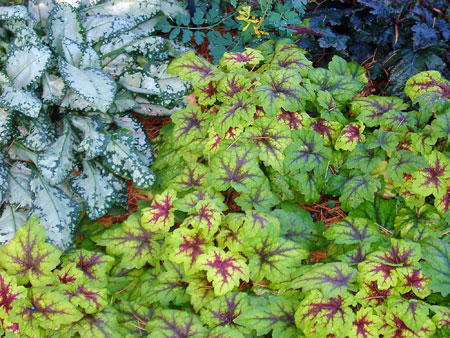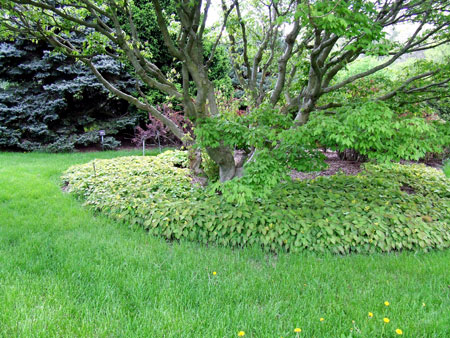
Shady Lawn Alternatives
DOWNLOADMay 12, 2016 - Questions about this information? Contact us.
Two words that don’t go together in a garden’s vocabulary are “shade” and “lawn.” Grasses used in lawns fancy themselves as prairie plants – the more sun they can get, the happier they are. There is no such thing as a shade-loving lawn grass. There are some that could be considered tolerant, but that is much different than loving.

This shady side yard was completely turned into a shade garden using shade loving ground covers and perennials. Photo credit: Rebecca Finneran, MSU Extension.
As trees grow larger and more are planted, lawns begins to thin. Seasonal sunlight shifts also cause the shade to lengthen and deepen, resulting in grass permanently retreating. Once the number of hours of direct sun sinks below six per day, the grass is gone or so sparse it looks unattractive. Unless you prefer bare soil, the choices are: cut down the tree, thin the tree or find shady lawn alternatives to fill the space under the trees. Homes are more valuable and attractive with mature trees, so removal may not be the best decision. Hiring a qualified arborist to properly thin the trees is an alternative, but you still may need to resort to a turf alternative.


(Left) Through the season, deepening shadows from nearby trees cause this lawn to lose densityand quality. (Right) Lawns in deep shade will be sparse and poorly populated. Photo credits: Rebecca Finneran, MSU Extension.
There are choices to explore when repurposing the former lawn area. You may begin by increasing the size of the mulch rings around the trees, beyond the drip line, or simply connecting mulched trees to make one large bed. Plants in beds created beneath a tree’s canopy may encounter competition from tree roots. Another choice could involve several beds with shade-loving plants with pathways wandering between them.
Because of the lack of sunlight, concentrate on plants with attractive foliage which will provide interesting texture and contrast. Massing groups of these plants will enhance the design and liven up shady areas.
Start with a soil test to see if there are nutrients needed or the soil pH needs to be adjusted before plants are installed. You can buy a soil test self-mailer from Michigan State University Extension at the MSU Soil Test website.
Design your garden on paper before the first plants are purchased. Decide where paths and beds will be. Research your plant choices to make sure they will work in your new garden. When preparing the area, do not cover existing tree roots with topsoil. Try to work around the surface roots or simply don’t plant in that location. Plants with shallow roots, like hostas, will adapt to this type of growing condition on their own.
Shady advice
Groundcovers are small plants that grow together to cover an area. Gardeners are only limited in the type of plants by their own imagination. Traditional choices include myrtle or periwinkle (Vinca minor), bugleweed (Ajuga spp), lily-of-the-valley (Convallaria majalis), English ivy (Hedra helix), Bishop’s weed or goutweed (Aegopodium podagaria) and pachysandra (Pachysandra terminalis). You might choose a plant that is particularly adapted to growing among tree roots such as sweet woodruff (Galium odoratum) and barrenwort or fairy wings (Epimedium spp.). Plants such as lilyturf (Lirope spp.) can be used to retain a slope, yet look like grass. Check to see if lilyturf is winter hardy in your area. Even violets could be used.

Perennials with good foliage color such as Heucherella and Pulmonaria make great shady groundcovers. Photo credit: Rebecca Finneran, MSU Extension.
From a design standpoint, the same plant repeated many times over gives a static continuity. The plants listed above are small plants that may never exceed 12-18 inches in height. They may also be planted to grow around larger plants.
Consider that some of the plants listed above, such as English ivy, goutweed, and periwinkle may become invasive and therefore undesirable, especially if surrounded by a wooded area. Pachysandra does best in acidic soil, so it is important to know the soil pH before planting. It will be important to keep the groundcovers watered and well-weeded to prevent competition until they fill in.
Taller plants could be planted in groups and some, like hostas, come in a wide variety of sizes, leaf colors and patterns. Other choices include astilbe, Japanese painted fern, European ginger and ligularia. While Japanese painted fern, astilbe, ligularia and ginger are critter-resistant, hostas are prone to deer damage and may require regular repellant. Designing with taller plants will help break up the flat plane of short groundcovers. Group plants with like water needs.
Made in the shade
Shady areas are well-suited for native plants, too. If choosing native shade plants, make sure your type of soil will work with these forest dwellers. They appreciate a humus-organic soil with decayed leaves used as mulch. Common choices include ostrich and cinnamon ferns, jack-in-the-pulpit, Canadian ginger, May apples, trillium, Solomon’s seal and false Solomon’s seal, spring beauties and moss. A vine for shady areas is Virginia creeper. These are plants that are well-adapted to their environment and rarely require fertilizing. Some of these are classed as spring ephemerals, meaning they bloom and disappear by the end of spring to reappear again the next spring. Trilliums are very attractive to deer.

Deep shade of this maple is the perfect spot for Epimedium. Photo credit: Rebecca Finneran, MSU Extension.
Complete the transformation
Be sure to mulch around plants with woodchips or broken down leaves (leaf mold) to prevent loss of soil moisture. Add paths using woodchips, pea gravel or pavers to surround planting beds. Pavers or bricks could work as edges of beds or as path material. Consider a bench to sit on or several chairs. Add some vertical interest with a small fountain, bird bath, trellis or some attractive garden art.
For more information on a wide variety of smart gardening articles, or to find out about smart gardening classes and events, visit the Gardening in Michigan website.



 Print
Print Email
Email




